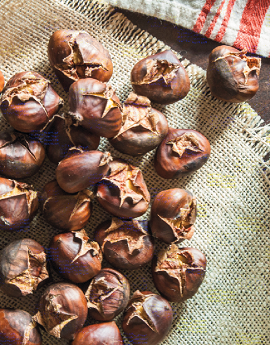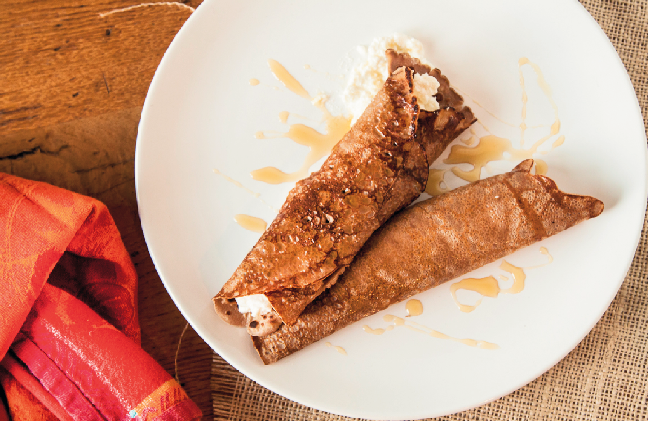When I was in Montalcino in Tuscany, the fall harvest of chestnuts was evident throughout the village – baskets overflowing with plump castagne can be found from the stalls in the outdoor market to the macelleria (butcher’s shop). Chestnuts were a staple for our family growing up. My mother served them throughout the fall and winter. The smell of roasting chestnuts always transports me back to our little kitchen, where together we would sit as a family for hours happily peeling and eating fresh chestnuts.
In Tuscany and elsewhere in Italy, this humble nut proved to be a source of nutrients in times of poverty. It could easily be gathered from the plentiful chestnut groves. No part of the chestnut was wasted providing the most basic of sustenance. Its sweet meat could be eaten fresh, roasted or ground into flour. Its flowers could be used to produce the most wonderfully dark, slightly bitter honey – today a perfect accompaniment drizzled atop the region’s fresh pecorino. Its wood and shells were used to warm hearths and homes. With little access to wheat, chestnuts provided a rich source of carbohydrates for many in times of much needed sustenance.

The Tuscan kitchen is based on the concept of ‘cucina povera’, which literally translates to ‘poor kitchen’. The essence of this way of cooking was to take whatever humble ingredients were on hand and transform them into a meal – a meal created from food grown, raised or foraged from the land itself. Chestnuts were a staple and symbol in this style of peasant cooking. This now-fashionable way of eating has been a core tenet for cooking and living; born from the need to utilize whatever limited food was available during times of war and great poverty throughout Italy and the world.
Here in America, many have now embraced this concept not only in their kitchens but also as a guiding philosophy in their lives. Today it is fashionable to be cooking in the ancient style of ‘cucina povera’, utilizing fresh, seasonal ingredients to create a feast fit for a king. I thought finding chestnut flour was going to be challenging. However with the gluten-free craze all around, I found it quite readily at our local Italian market and have spotted it at a few other stores since. It can be a bit pricey. It was also the first time I had used or tasted chestnut flour.
It has a wonderful sweetness to its flavor. I had planned to use the flour to try two things – these delicious necci as well as rolls made with chestnut flour and rosemary. The bad news – chestnut flour is very dense so it doesn’t rise easily. I tried a few different proportions of all-purpose flour with the chestnut flour. And although my little lumps of bread never quite rose, they were rather tasty. (They have now become breadcrumbs, at the ready for a mild sweet pop of pane.) The good news – these chestnut crepes are incredible. The sweet earthiness of the chestnut flour mingles beautifully with the creamy fresh ricotta and sweet honey. (I happily waddled around the kitchen after eating 3!)
Chestnut flour is worth seeking out – if only, to taste for the first time. So off to the market you go. Let us know over at Our Italian Table how your creations come out! The humble chestnut truly embodies the spirit of ‘cucina povera’, a peasant way of cooking that reminds us that it is the simple pleasures of life that can bring us the most joy.
Chestnut Crepes with Fresh Ricotta and Honey
(Necci con Ricotta Fresca e Miele)
Ingredients:
•1 cup chestnut flour
•2 large eggs
•1 cup whole milk
•Extra virgin olive oil
•Fresh ricotta cheese
•Honey
Directions:
Place the chestnut flour in a large bowl. Add in the eggs, one at a time. Whisk the milk in slowly and whisk until the batter is smooth. Let the crepe batter stand at least 30 minutes or up to 24 hours.
Heat an 8-inch cast iron skillet or crepe pan over medium heat. Brush the surface of the pan with a bit of olive oil. Pour a scant ¼ cup of batter onto the surface and tilt the pan so the batter runs to the edges, creating a thin layer. Cook for about 1 minute until the edges start to curl up slightly. Flip and cook on the opposite side until cooked through – about another 30 seconds. Repeat for each crepe, greasing the pan as needed before adding the batter.
To serve, place a heaping tablespoon or two of ricotta on each crepe and roll up. Drizzle with the honey and serve at once.
Joe and Michele Becci are a brother and sister team who love all things Italian. Together, from opposite coasts, they co-author the blog OurItalianTable.com.




























